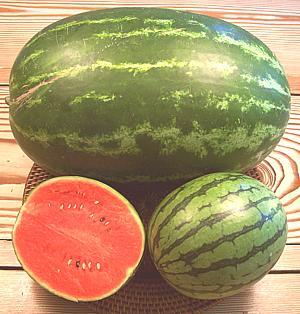 [Citrullus lanatus]
[Citrullus lanatus]
Watermelons originated in southern Africa but were already grown as a crop in Egypt 5000 years ago and are now planted throughout the world. China got them in the 10th century CE and is now the largest producer. They were brought to North America in the 16th century where California, Georgia, Arizona and Texas are the major producers.
Watermelon fruit is unlike the Cucumus melons of Western Asia in that they are not hollow in the center but have a uniform pulp throughout. Many sizes have been developed (the examples here are 22 pounds for the large and 3-3/4 pounds for the small) and a number of colors. Yellow and white are fine for decorative accents, but as usual I recommend the standard red color as the best tasting,
Seedless Watermelons are not actually without seeds, but the seeds are all or mostly immature, white and very soft when the melon is ripe. Making a seedless watermelon is quit a feat of genetic engineering, but personally I don't see the point - I've always just swallowed the seeds anyway so they don't bother me. I, and many others, find the standard watermelon to have better flavor and texture than manipulated ones.
The ancestral Watermelon (Citrullus lanatus var citroides), known as the Citron Melon, is still extant and is now wild in Southern and Baja California, though nobody knows how it got there. The white flesh is so firm it's sort of "rind all the way through", but its high pectin content makes it popular for preserves.
More on Melons.
The main use of Watermelons is to just slice and eat, though they are also used in drinks and various fruit concoctions. Watermelon juice is sometimes boiled down to make a sweet syrup. Watermelon rind is often pickled in the U.S. and particularly Russia, but more properly that should be the Citron Melon. In any case, the green skin is peeled off before pickling.
Watermelons have long been used as a way to sneak alcoholic beverages into "dry" events. You cut a small hole at one end and keep pouring 100 proof vodka into it until it will take no more. Then plug the hole with the piece you cut out. If you do it carefully it'll be practically invisible. This concoction is called a "hard watermelon".
Watermelon is kind of a weakness of mine - I'll eat watermelon until I'm in pain, then go back for more as soon as I can. At Chamber of Commerce mixers I tend to hang around the fruit plate and eat all the watermelon.
Some years ago a group of researchers made the claim that Watermelon contained a substance practically identical to Viagra. "For Science!", I bought a pretty large Watermelon and ate it in a single sitting. Well, actually, when I was in pain I'd go lie down for a bit to recover, then come back and eat more. My observation: "No Effect".
An associate who used to post under the name "Bionerd" suggested the substance might be in the rind. So, again, "For Science!", I bought another, and ate it in one sitting including the rind right out to the green skin. My obseration: "No Effect".
ml_waterz 071005
©Andrew Grygus
- ajg@aaxnet.com - Linking and non-commercial use permitted